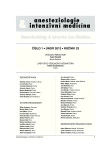Use of neuromuscular blocking agents in general anaesthesia for surgery: A three-month, single-centre study in a Czech regional hospital
Authors:
Herold Ivan 1; Sittová Naděžda 1; Čurdová Marcela 1; Adamus Milan 2
Authors place of work:
Anesteziologicko-resuscitační oddělení, Oblastní nemocnice Mladá Boleslav, a. s.
1; Klinika anesteziologie, resuscitace a intenzivní medicíny, Fakultní nemocnice a Lékařská fakulta Univerzity Palackého v Olomouci
2
Published in the journal:
Anest. intenziv. Med., 23, 2012, č. 1, s. 6-13
Category:
Anesteziologie - Původní práce
Summary
Objective:
Use of NMBAs in surgical anaesthesia.
Design:
Single-center, three-month analysis of anaesthesia charts (MBrelax2008).
Setting:
Department of Anaesthesiology and Intensive Care of a regional general hospital.
Materials and methods:
The observed parameters in surgical anaesthesia included the use of general anaesthesia (GA), regional anaesthesia (RA), suxamethonium and non-depolarising NMBAs. The results were compared to data from the observational one-day Czech Anesthesia Day (CAD2010).
Results:
Total 2316 anaesthesia charts from the observed period were evaluated. GA was used in 72.6 % (CAD2010 92.9 %, p < 0.0001). Orthopaedics/Trauma (366; 48.8 %), General Surgery (343; 80.3 %), Urology (248; 72.9 %), ENT (306; 100 %), Gynae/Obstetrics (406; 84.4 %) and Ophthalmology (12; 100 %). NMBAs were administered to 634 patients (37.7% vs 54.7% in CAD2010, p < 0.0001), most often in G/S (271; 79 %). LMA was inserted without facilitation by NMBAs in 478 (28.4 %) patients. Suxamethonium alone was used in 33 patients (2 % GA) only, most frequently in G/O. In the MBrelax2008 study, non-depolarizing NMBAs only were administered to 471 patients (28 % GA) vs. 684 (36.1% GA) in CAD2010 (p < 0.0001). Rocuronium was administered more often than cisatracurium (20.8 % vs. 13.8 %, p < 0.0001).
Conclusion:
Comparing with CAD2010, surgery was performed under GA less frequently, reflecting increasing preference of RA in the center. This correlates with the lower use of NMBAs. LMA were more often inserted without NMBAs. Rocuronium is the most frequently used NMBA. The results point to the difficulties experienced when comparing the data from observational multi-center studies with current clinical practice. The data should be evaluated for longer periods and comparable centers.
Keywords:
general anaesthesia – regional anaesthesia – pharmaco-economics – NMBA – suxamethonium – rocuronium – cisatracurium
Zdroje
1. Loughlin, K. A. A pharmacoeconomic analysis of neuromuscular blocking agents in the operating room. Pharmacotherapy, 1996, 16, p. 942.
2. Chambers, D., Paulden, M., Paton, F., Heirs, M., Duffy, S., Craig, D. et al. Sugammadex for the reversal of muscle relaxation in general anaesthesia: a systematic review and economic assessment. Health Technol. Assess., 2010, 14, 39, p. 1–211.
3. Paton, F., Paulden, M., Chambers, D., Heirs, M., Duffy, S., Hunter. J. M., Sculpher, M., Woolacott, N. Sugammadex compared with neostigmine/glycopyrrolate for routine reversal of neuromuscular block: a systematic review and economic evaluation. Br. J. Anaesth., 2010, 105, 5, p. 558–567.
4. Naguib, M., Kopman, A. F., Lien, C. A., Hunter, J. M., Lopez, A., Brull, S. J. A survey of current neuromuscular block in the United States and Europe. Anesth. Analg., 2010, 111, p. 110–119.
5. Murphy, G. S., Szokol, J. W., Marymont, J. H., Greenberg, S. B., Avram, M. J., Vender, J. S. Residual Neuromuscular Blockade and Critical Respiratory Events in the Postanesthesia Care Unit. Anesth. Analg., 2008, 107, p. 130–137.
6. Brull, S., Naguib, M., Miller, R. Residual Neuromuscular Block: Rediscovering the Obvious. Anesth. Analg., 2008, 107, p. 11–14.
7. The Joint commission: Sentinel Event Alert, Issue 32 2 – October 6, 2004. Preventing, and managing the impact of, anesthesia awareness. Dostupné na:
http://www.jointcommission.org/assets/1/18/SEA_32.PDF
8. Černý, V., Adamus, M., Cvachovec, K., Ševčík, P., Herold, I. Anestezie v České republice 2010 – jednodenní prospektivní observační dotazníková studie. Anest. intenziv. Med., 2011, 22, s. 5–12.
9. Adamus, M., Herold, I., Cvachovec, K., Ševčík, P., Černý, V. Svalová relaxace během celkové anestezie v České republice 2010 – jednodenní prospektivní observační dotazníková studie. Anest. intenziv. Med., 2011, 22, s. 82–89.
10. Drábková, J. Statistika oboru anesteziologie a resuscitace (2010). Anest. intenziv. Med., 2011, 22, p. 233–238.
11. Lee, C. L. Goodbye Suxamethonium! Anaesthesia, 2009, 64, S1, p. 73–81.
12. Umesh, G., Jasvinder, K., Shetty, N. Suxamethonium stands the test of time: it is too early to say goodbye. Anaesthesia, 2009, 64, p. 1023.
13. Cerny, V., Herold, I., Cvachovec, K., Sevcik, P., Adamus, M. Guidelines for managing neuromuscular block: not only Czech beer deserves a taste. Anesth. Analg., 2011, 112, p. 482.
14. Herold, I. Myorelaxancia v dětské anesteziologii. In Gašparec, P. et al. Princípy detskej anestézie. 1. vydání. Martin: Osveta, 2010, p. 76–88. ISBN 978-80-8063-340-0.
15. Herold, I. Svalová relaxancia v anesteziologii a intenzivní péči. 1. vydání. Praha: Maxdorf, 2004, 268 s. ISBN 80-7345-025-0.
Štítky
Anesteziologie a resuscitace Intenzivní medicínaČlánek vyšel v časopise
Anesteziologie a intenzivní medicína

2012 Číslo 1
- MUDr. Lenka Klimešová: Multioborová vizita může být klíčem k efektivnější perioperační léčbě chronické bolesti
- Neodolpasse je bezpečný přípravek v krátkodobé léčbě bolesti
- Léčba akutní pooperační bolesti z pohledu ortopeda
- Realita léčby bolesti v paliativní péči v Německu
- Perorální antivirotika jako vysoce efektivní nástroj prevence hospitalizací kvůli COVID-19 − otázky a odpovědi pro praxi
Nejčtenější v tomto čísle
- Kvalita a včasné komplikace pooperační epidurální analgezie po rozsáhlých výkonech
- Tromboprofylaxe a neuroaxiální anestezie v porodnictví
- Doporučení pro léčbu toxické reakce po podání lokálních anestetik
- Použití svalových relaxancií při celkové anestezii v operačních oborech – tříměsíční unicentrická studie v české regionální nemocnici
